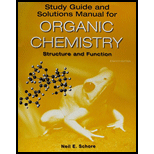
(a)
Interpretation: The structure of major organic product that would result from reaction of
Concept introduction: Carbocation formation is relatively slower than acid-base reactions. Carbocations generated from
Analogous to the case that strong nucleophiles are more favored to react via
(b)
Interpretation: The structure of major organic product that would result from reaction of
Concept introduction: Carbocation formation is relatively slower than acid-base reactions. Carbocations generated from alkyl halides have two fates; they can be either trapped by nucleophiles to give substitution product or may deprotonated to yield small amount of alkene. Stronger the base more is the probability of elimination over substitution over elimination. Further, if still higher concentration is employed reaction proceeds via bimolecular elimination. On the other hand, weak base waits until the carbocation is formed and the type of elimination with relatively weak base is two-step elimination or
Analogous to the case that strong nucleophiles are more favored to react via
(c)
Interpretation: The structure of major organic product that would result from reaction of
Concept introduction: Carbocation formation is relatively slower than acid base reactions. Carbocations generated from alkyl halides have two fates; they can be either trapped by nucleophiles to give substitution product or may deprotonated to yield small amount of alkene. Stronger the base more is the probability of elimination over substitution over elimination. Further if still higher concentration is employed reaction proceeds via bimolecular elimination. On the other hand weak base waits until the carbocation is formed and the type of elimination with relatively weak base is two-step elimination or
Analogous to the case that strong nucleophiles are more favored to react via
Want to see the full answer?
Check out a sample textbook solution
Chapter 7 Solutions
EBK STUDY GUIDE/SOLUTIONS MANUAL FOR OR
- Calculate the pH and the pOH of each of the following solutions at 25 °C for which the substances ionize completely: (a) 0.200 M HClarrow_forwardCalculate the pH and the pOH of each of the following solutions at 25 °C for which the substances ionize completely: (a) 0.000259 M HClO4arrow_forwardWhat is the pH of a 1.0 L buffer made with 0.300 mol of HF (Ka = 6.8 × 10⁻⁴) and 0.200 mol of NaF to which 0.160 mol of NaOH were added?arrow_forward
- Determine if the following salt is neutral, acidic or basic. If acidic or basic, write the appropriate equilibrium equation for the acid or base that exists when the salt is dissolved in aqueous solution. If neutral, simply write only NR. Be sure to include the proper phases for all species within the reaction. NaN₃arrow_forwardCan I please get help with this?arrow_forwardCan I please get help with this?arrow_forward
- Use the Henderson-Hasselbalch equation to calculate pH of a buffer containing 0.050M benzoic acidand 0.150M sodium benzoate. The Ka of benzoic acid is 6.5 x 10-5arrow_forwardA. Draw the structure of each of the following alcohols. Then draw and name the product you would expect to produce by the oxidation of each. a. 4-Methyl-2-heptanol b. 3,4-Dimethyl-1-pentanol c. 4-Ethyl-2-heptanol d. 5,7-Dichloro-3-heptanolarrow_forwardWhat is the pH of a 1.0 L buffer made with 0.300 mol of HF (Ka = 6.8 × 10⁻⁴) and 0.200 mol of NaF to which 0.160 mol of NaOH were added?arrow_forward
- Can I please get help with this.arrow_forwardDetermine if the following salt is neutral, acidic or basic. If acidic or basic, write the appropriate equilibrium equation for the acid or base that exists when the salt is dissolved in aqueous solution. If neutral, simply write only NR. Be sure to include the proper phases for all species within the reaction. N₂H₅ClO₄arrow_forwardPlease help me with identifying these.arrow_forward
 Organic ChemistryChemistryISBN:9781305580350Author:William H. Brown, Brent L. Iverson, Eric Anslyn, Christopher S. FootePublisher:Cengage Learning
Organic ChemistryChemistryISBN:9781305580350Author:William H. Brown, Brent L. Iverson, Eric Anslyn, Christopher S. FootePublisher:Cengage Learning
